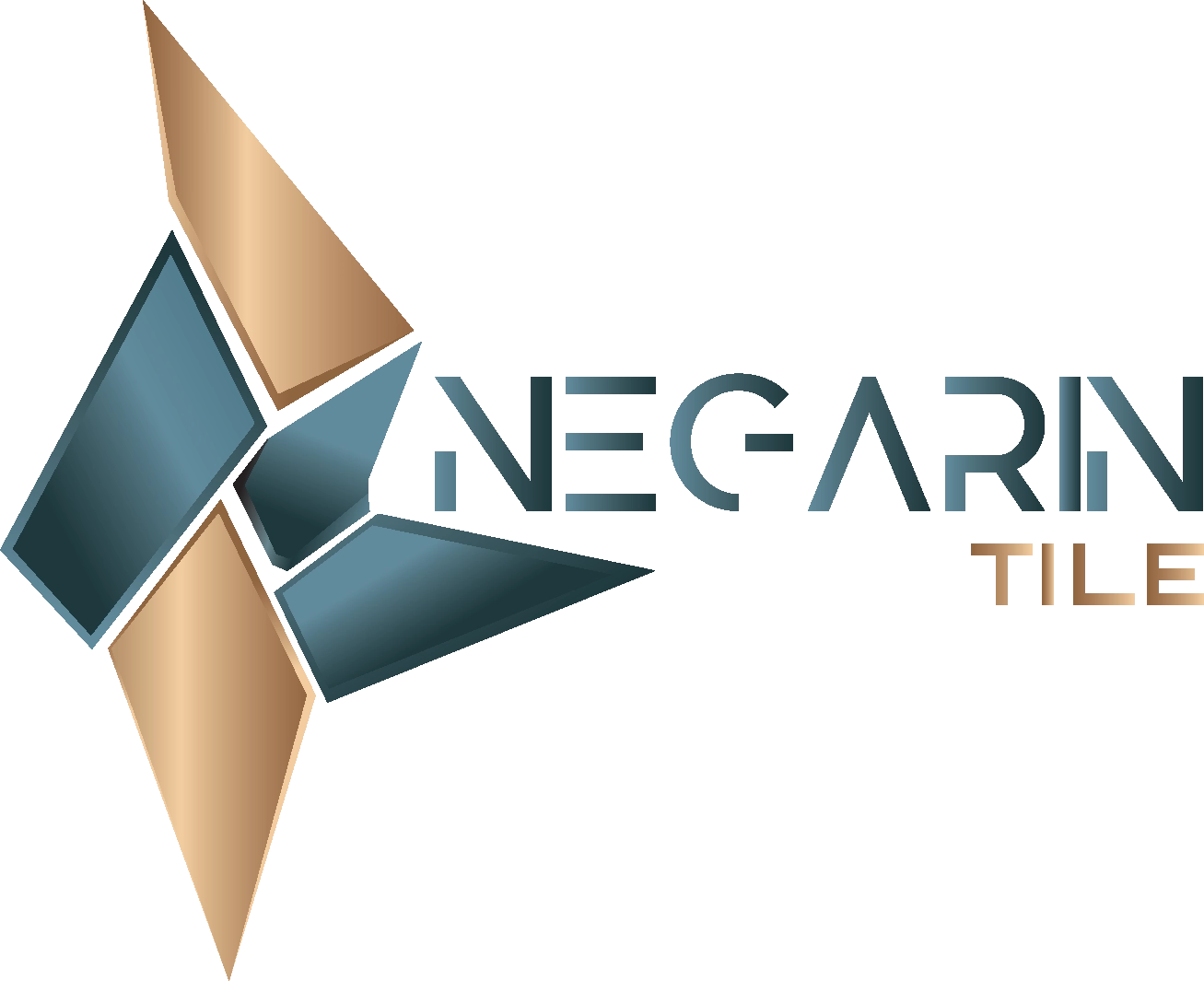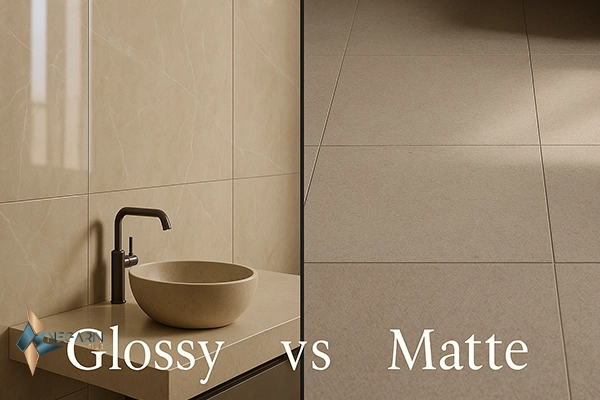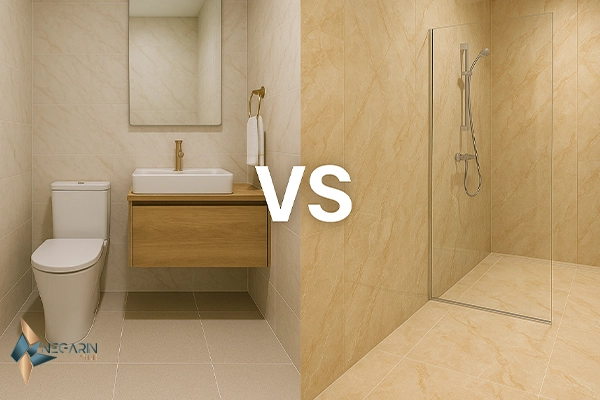Porcelain vs ceramic tiles: porcelain is denser and less porous (water absorption ≤0.5%), so it’s tougher and better for floors, wet zones, and light-commercial use. Ceramic is lighter, easier to cut, and cost-effective for walls and low-traffic floors.
Introduction: Why this choice matters
If you are planning a remodel or specifying materials for a project, the debate over porcelain vs ceramic tiles defines how your space will perform for the next decade. Both are fired clay products, usually glazed, but porcelain’s refined clays and higher firing temperatures create a tight microstructure with extremely low water absorption. That single property—how much water a tile absorbs—explains most of the performance gap you’ll feel underfoot.
Across kitchens, bathrooms, foyers, and hospitality settings, choosing correctly in porcelain vs ceramic tiles influences installation difficulty, maintenance workload, and total cost of ownership. This guide brings together standards, a quick comparison table, deep-dive explanations, and a decision framework you can print and take to site.
Standards at a glance
- Porcelain: water absorption ≤0.5% (typical porcelain standard).
- Ceramic: usually higher absorption (often 3–7% for common wall/floor ceramics).
- Always check the technical data sheet: absorption, PEI wear class, and DCOF slip value are the three numbers that should steer your decision in porcelain vs ceramic tiles.
Comparison Table (Quick Look)
| Factor | Porcelain Tile | Ceramic Tile | What it means |
|---|---|---|---|
| Water absorption | ≤0.5% | >0.5% (often 3–7%) | Porcelain resists moisture; safer for wet zones and some exteriors. |
| Density/strength | Higher density; tougher | Lower density | Better impact/wear resistance with porcelain. |
| Wear (PEI) | Floors often PEI 3–5 | Many PEI 2–4 | Check PEI for floor suitability regardless of material. |
| Slip (DCOF) | Finish-dependent | Finish-dependent | Prioritize DCOF/texture over material label for wet floors. |
| Formats & thickness | Large formats common (e.g., 60×120) | Mostly standard sizes | Fewer grout lines with large porcelain slabs. |
| Edges | Often rectified | Frequently pressed | Rectified edges allow tight, even joints (≈2–3 mm). |
| Finishes | Polished, matte, structured, realistic stone/onyx | Broad, fewer structured | More anti-slip textures in porcelain lines. |
| Cutting/installation | Harder; pro tools, more time | Easier; DIY-friendly | Impacts labor cost/schedule. |
| Maintenance | Highly stain-resistant | Easy-care but softer | Both clean with neutral-pH; glaze usually needs no sealing. |
| Outdoor/freeze-thaw | Often suitable (verify rating) | Typically interior only | Exteriors generally call for porcelain. |
| Shade variation | V1–V4 across looks | V1–V3 common | Higher V-ratings = more pattern movement. |
| Weight per m² | Heavier | Lighter | Matters for wall substrates and handling. |
| Typical cost | $$–$$$ | $–$$ | Ceramic saves upfront; porcelain saves in tough areas. |
| Lead times | May vary with formats | Often faster | Check availability early in the spec process. |
| Best uses | Floors, wet rooms, commercial, some exteriors | Walls, splashbacks, low-traffic floors | Choose by traffic/moisture exposure. |
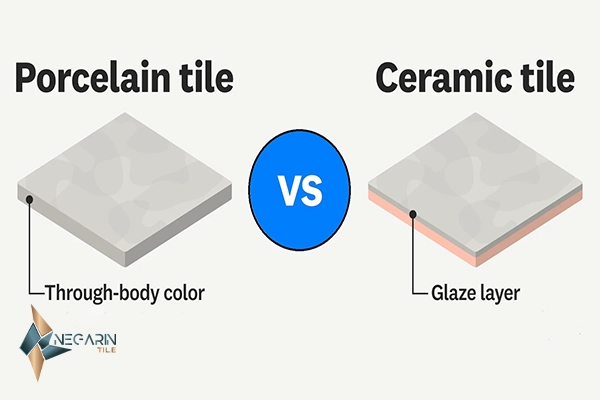
11 Key Differences in porcelain vs ceramic tiles
1) Water Absorption & Porosity
Porcelain’s ≤0.5% absorption radically reduces moisture ingress and freeze-thaw risk. Ceramic absorbs more, which is fine indoors where the environment is controlled.
What it means for you: bathrooms, showers (walls), laundry floors, and entries typically favor porcelain in the porcelain vs ceramic tiles decision.
2) Density & Strength
The dense porcelain body resists chipping, cracking, and heavy wear better than standard ceramic.
Takeaway: For hallways, kitchens, and retail aisles, porcelain wins on toughness; ceramic excels on feature walls and lighter residential floors.
3) PEI Wear Rating
PEI (1–5) measures glaze wear. Floors generally need PEI 3+ whether porcelain or ceramic.
Tip: Don’t assume porcelain always outperforms—look at PEI. A PEI-4 ceramic can beat a low-PEI porcelain on surface wear.
4) Slip Resistance (DCOF) & Finish
Safety depends on DCOF and surface texture. Gloss can feel slick; matte/structured finishes offer more grip.
Use it this way: in porcelain vs ceramic tiles, select matte/structured for wet floors and keep glossy for walls or dry, low-traffic floors.
5) Formats & Thickness
Porcelain commonly offers large-format sizes (e.g., 60×120 and slabs), minimizing joints and cleaning lines. Ceramic’s sweet spot is classic sizes like 60×60, 30×60, and wall modules.
Design effect: large formats visually enlarge rooms and support modern minimalism.
6) Edges & Joint Width
Rectified porcelain allows tighter joints (~2–3 mm) for a continuous look. Pressed edges—common in ceramic—need a little more joint width to account for size variation.
Installer note: for glass-smooth results in porcelain vs ceramic tiles, rectified porcelain is a simpler path.
7) Aesthetics & Finishes
Both categories deliver glossy and matte; porcelain lines often push realism further—marble-look, onyx-look, and gemstone collages with convincing depth.
Styling: pair marble-look porcelains with brass and warm woods; use subtle ceramic on walls to balance statement floors.
8) Installation Difficulty
Porcelain requires water-saws, diamond blades, and often leveling systems for large formats. Ceramic is easier to cut and lighter to handle.
Budget impact: labor can be higher for porcelain; factor it early when comparing porcelain vs ceramic tiles.
9) Maintenance & Stain Resistance
Glazed porcelain resists stains exceptionally and cleans with neutral-pH products. Glazed ceramic is also easy-care but slightly softer.
Daily life: both are low-maintenance; porcelain holds its finish longer in demanding zones.
10) Outdoor & Freeze-Thaw Suitability
Exterior-rated porcelain works in covered patios and unheated spaces; ceramic is typically interior only.
Rule of thumb: when the project includes the outdoors, porcelain vs ceramic tiles defaults to porcelain—verify frost and exterior ratings.
11) Price & Lifetime Value
Ceramic wins on sticker price; porcelain reduces replacement risk and maintenance in high-use spaces.
TCO view: for busy family homes or hospitality, porcelain’s longevity often offsets the higher upfront cost.
Manufacturing: Why they behave differently
Porcelain uses refined clays and higher firing temperatures to create a tight, vitrified microstructure. Many porcelain tiles are color-body or through-body, so minor chips are less visible. Ceramic typically uses a red or white body with a robust glaze and is optimized for wall performance and versatility. Understanding this background helps you judge porcelain vs ceramic tiles beyond marketing claims.
Finish Guide: Glossy, Matte, Structured
- Glossy: wall features, splashbacks, and low-splash floors; amplifies light and pattern.
- Matte: forgiving with footprints, better perceived traction; ideal for busy floors.
- Structured/Grip: micro-textures for shower floors, entrances, and ramps.
Even when weighing porcelain vs ceramic tiles, the finish is often the decisive factor for safety and comfort.
Formats, Patterns & Design Playbook
- Large-format (60×120 & slabs): fewer grout lines, modern minimalism, easier cleaning.
- Classic 60×60: balanced scale, efficient waste, effortless alignment in grids.
- Patterns: herringbone, basketweave, running bond, and modular mixes can transform a single colorway.
- Floor-to-wall continuity: continue a marble-look porcelain from floor onto the vanity wall for a luxury, hotel-style effect.
Internal link ideas:
Marble-look porcelain (SOHA Beige, PEPSI Brown, EMAD Cream, AZORIT Beige) • Onyx-look porcelain (ALFA Ivory, LANDA Beige, MORVARID) • Micro-stone (AZARRAKHSH Cream).
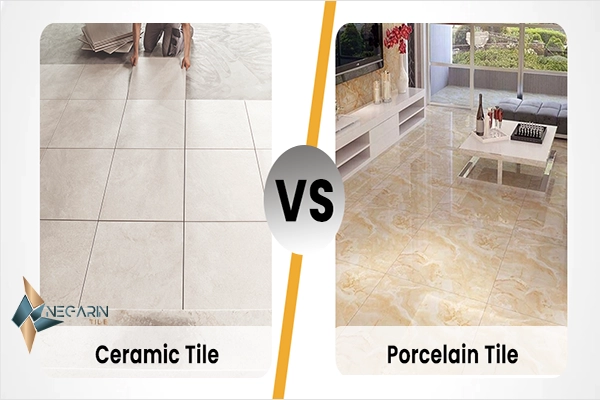
Best Uses (Decision Guide for porcelain vs ceramic tiles)
Choose Porcelain When…
- High-traffic floors: kitchens, corridors, open-plan living, boutiques, cafés, hotel lobbies
- Wet zones: bathroom floors, shower walls, laundries, entries
- Large-format designs with narrow joints (rectified edges)
- Exterior areas (when the product is rated for frost/exterior use)
Choose Ceramic When…
- Walls & splashbacks where cuts are frequent and weight matters
- Budget-sensitive floors with low to moderate residential traffic
- DIY projects that benefit from faster cutting and lighter handling
- Feature walls where color, pattern, and tile layout take priority over density
Cost Comparison: Materials, Labor & Lifetime
Choosing between porcelain vs ceramic tiles is a balance of sticker price and lifecycle value.
Materials: ceramic usually offers a lower price per m²; porcelain costs rise with large formats, specialty finishes, and rectified edges.
Labor: porcelain takes longer to cut and set, particularly in 60×120 or slab formats; installers may require water-saws, extra blades, and leveling systems.
Accessories: mortars designed for low-absorption bodies, grout (sanded/unsanded), spacers, clips, and sealant for grout joints.
Waste Allowance: plan 10% for straight lay, 15%+ for diagonal and complex patterns.
Lifetime Value: in busy kitchens, entries, and hospitality, porcelain reduces the risk of early replacement—an advantage often missed in simple cost comparisons of porcelain vs ceramic tiles.
Example Calculation (living room 30 m²)
- Material: porcelain 60×60 at $$ vs ceramic at $
- Waste 10% → order 33 m²
- Labor: porcelain +15–25% vs ceramic due to cutting/leveling
- Over 10 years: porcelain typically lowers refinishing/replacement risk
Installation Basics & Substrate Prep
No matter where you land in porcelain vs ceramic tiles, installation determines 90% of the finished result.
- Flatness: large formats demand flatter substrates; self-leveling compounds can save the day.
- Mortar: porcelain’s low absorption benefits from high-bond thinset; back-butter large tiles for full coverage.
- Joint width: rectified porcelain often runs at 2–3 mm; pressed edges may need more.
- Lippage control: use leveling clips for formats ≥60×60.
- Movement joints: honor room perimeters and transitions; use profiles in large areas.
- Heated floors: both materials suit radiant systems—follow adhesive manufacturer guidance.
Care, Cleaning & Long-Term Appearance
- Daily/weekly: neutral-pH cleaner, microfiber mop; avoid oil-soap/acidic products that haze grout.
- Sealing: glazed porcelain and ceramic generally don’t need sealing; grout does—this single step halves maintenance.
- Protection: felt pads under furniture; entry mats reduce abrasion.
- Stain tips: for stubborn marks, use non-abrasive pads with manufacturer-approved cleaners.
Room-by-Room Recommendations
- Bathrooms: porcelain floors with matte/structured finishes; glossy ceramic or porcelain for walls.
- Kitchens: porcelain floors (PEI 3–5); ceramic splashbacks; consider rectified porcelain for seamless floor-to-island runs.
- Living areas: either works—choose porcelain for pets/kids/high traffic.
- Entries & mudrooms: porcelain with suitable DCOF; darker grout hides soil.
- Retail/hospitality: porcelain with rectified edges for clean lines and simple maintenance.
- Covered outdoor: exterior-rated porcelain; verify frost and DCOF requirements.
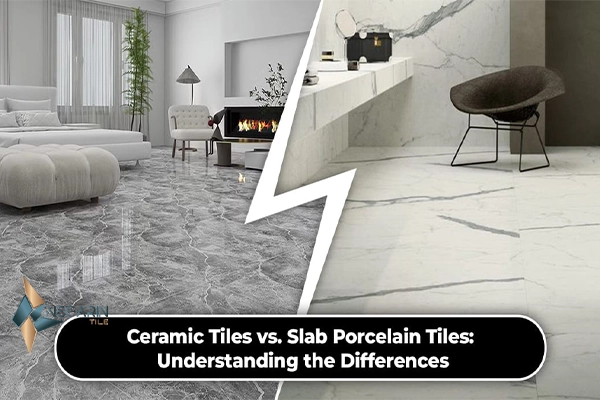
Myths & Misconceptions about porcelain vs ceramic tiles
- “Porcelain is always non-slip.” False—finish and DCOF decide slip resistance.
- “Ceramic can’t be used on floors.” It can—check PEI and traffic level.
- “Porcelain always costs a lot more.” Not always; mid-range porcelains can be close to ceramics, especially in 60×60.
- “All porcelain is the same.” No—ratings, finishes, and edge types vary widely.
- “Sealing is required.” Glazed surfaces usually don’t need sealing; grout does.
Spec Template (copy-paste for your project)
Material: [Porcelain/Ceramic], glazed, color-body where noted
Format: [60×60 / 60×120 / slab] • Edge: [rectified/pressed] • Finish: [matte/polished/structured]
Performance: Absorption [≤0.5% for porcelain] • PEI [≥3 floors] • DCOF [meets area requirement]
Install: Thinset high-bond (porcelain), back-butter large formats, joints 2–3 mm rectified / 3–4 mm pressed
Areas: [bath floor], [shower walls], [kitchen floor], [entry]
Notes: Honor movement joints; seal grout; follow curing times.
Use this template whether you end up on the porcelain side or the ceramic side of the porcelain vs ceramic tiles debate.
Common Mistakes to Avoid
- Using wall-only ceramic on floors without checking PEI.
- Choosing glossy floors in wet entries instead of higher-grip finishes.
- Skipping substrate prep and leveling for large formats.
- Ignoring movement joints around room perimeters.
- Selecting extreme grout color contrast that visually “boxes” the design.
Conclusion: Clear takeaways for porcelain vs ceramic tiles
For high-traffic or wet zones, porcelain vs ceramic tiles typically favors porcelain because of density and low absorption. For walls, feature areas, and budget-friendly updates, ceramic delivers outstanding style with easier cutting and quicker installs. Match finish and DCOF to the room, choose rectified edges when you want narrow joints, and plan your substrate prep—those choices will decide how premium the result feels.
Ready to Choose Your Tiles?
Compare porcelain vs ceramic tiles in your space and see the finish that fits—marble-look, onyx-look, or micro-stone in 60×60 & large formats. Project-ready stock, consistent batches, expert support.
FAQ
Which is better in porcelain vs ceramic tiles for bathroom floors?
Porcelain. Its ≤0.5% absorption and higher density suit wet, high-use floors. Select a matte/structured finish with a suitable DCOF and use a high-bond mortar.
Can ceramic tiles be used on floors?
Yes—if the PEI rating suits floor traffic (generally PEI 3+). Ceramic is excellent for walls and many residential floors with moderate use.
Do porcelain tiles need sealing?
Glazed porcelain generally does not need sealing. Seal the grout to reduce staining and simplify cleaning.
Are porcelain vs ceramic tiles more expensive to install?
Porcelain tends to be pricier to install due to harder cutting, heavier handling, and leveling needs—especially in large formats.
What DCOF rating is safe for wet areas?
Many specifiers target a wet DCOF ≈ 0.42 or higher for interior floors; always verify the product sheet and local code requirements.
What’s the difference between glazed and through-body porcelain?
Glazed porcelain has a decorative surface over a dense body; through-body/color-body porcelain carries color through the tile so small chips are less visible.
Will glossy tiles scratch more easily?
Gloss shows micro-scuffs more obviously; use mats and felt pads. For busy floors choose matte or structured finishes—porcelain vs ceramic tiles both benefit from this rule.
Can I use large-format tiles in small bathrooms?
Yes—fewer grout lines can make small rooms feel larger. Ensure proper substrate flatness and use leveling clips.
Are porcelain tiles colder than ceramic?
Both feel similar underfoot and both work well with radiant heat when installed per system guidelines.
How do I choose grout width and color?
Rectified porcelain often looks best at 2–3 mm with a matching grout tone. Pressed ceramic may need 3–4 mm. Closer color matches minimize “grid” effects.
